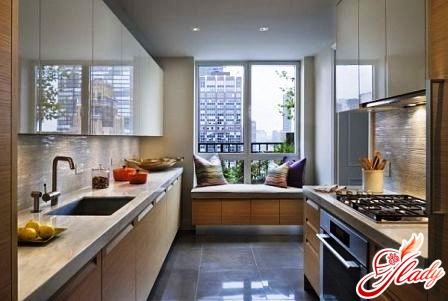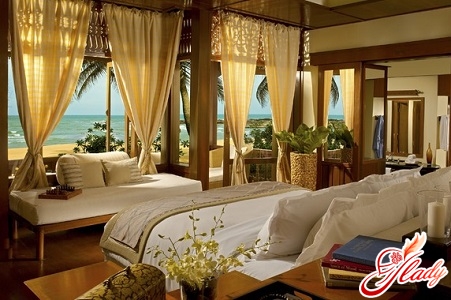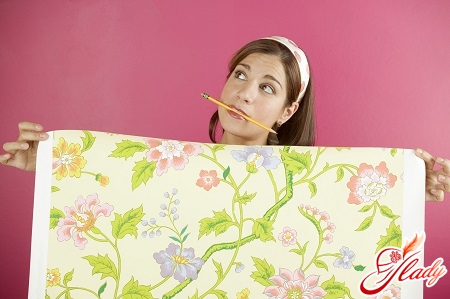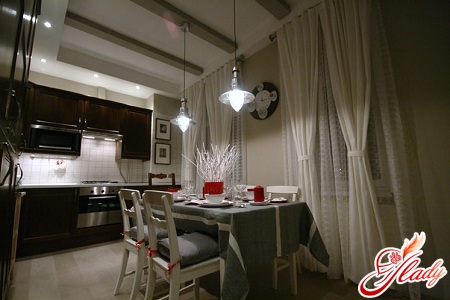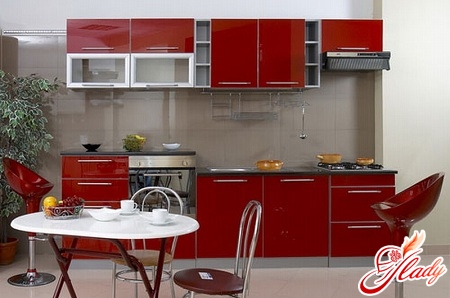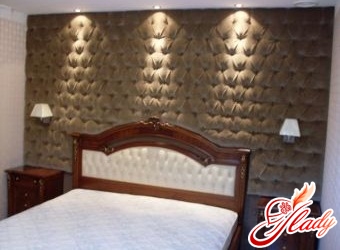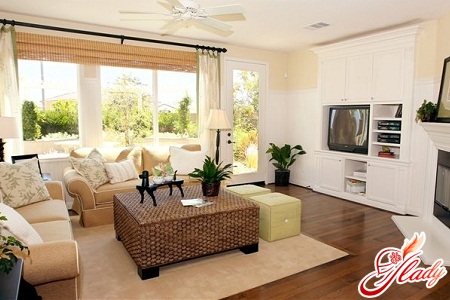 Mediterranean style in the interior isthe style of European countries, associated with the warm sea, bright sun and rich flora. This is an atmosphere of warmth, comfort, coziness and at the same time simple-hearted simplicity, characteristic of all Europeans. The main components of the interior in the Mediterranean style are:
Mediterranean style in the interior isthe style of European countries, associated with the warm sea, bright sun and rich flora. This is an atmosphere of warmth, comfort, coziness and at the same time simple-hearted simplicity, characteristic of all Europeans. The main components of the interior in the Mediterranean style are:
- Low wooden furniture in combination with forged items
- Window decoration with muslin and blinds
- Demonstration of ordinary dishes, used every day, on open shelves
- Cane chairs in the dining area
- The use of hand embroidery in the furnish of textiles (pillows, bed linens)
- Floor finishing - wooden planks or terracotta tiles
- "Naive" lace, used in the tracks on the dining table and cushions for pillows
- "Earth" colors for the Italian interpretation of the interior and the "marine" combination of colors for the interior in the Greek style
Is this style right for you?
This interior style definitely suits you,if you live in an old mansion or a house with plenty of sunlight in the rooms. The Mediterranean interior style will also suit you if you like country, but would like to create a more spacious and less colorful version of it. Such an interior will be a real find for people who adore a festive atmosphere and a relaxed atmosphere in the house. But you should definitely not get involved with it if you live in a house whose windows face north, that is, are constantly in the shade and you will not tolerate tiled floors in any room.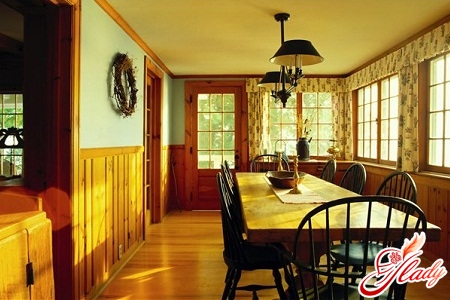
Color palette
To create an impression of freshness and vigorFor a light-filled interior, the "Greek" range of transparent shades is most suitable. And for creating a sense of coziness and sophistication, the Italian style color palette is more relevant. Here are some tips to help you understand the selection of colors:
- Mediterranean style in a home interior is best formed using the three primary colors used in each room for walls, floors and furniture
- To create an urban "Italian" interior, you can use a larger number of similar shades of tone
- The main color for the "Greek" home is white, it serves as a background for more vivid interior details
Color scheme of the Greek style:The "Greek" palette is not very diverse and consists of white, turquoise shades of the sea, blue shades of the sky and pink color of bougainvillea plants. This color combination creates a feeling of summer all year round, an abundance of light and air. Roughly plastered walls, shiny whitewashed floors and painted furniture are ideal for this color scheme. Italian style palette: The colors of this style are filled with the energy of the sun and warmth taken from nature itself. These are the colors of ripe golden wheat, olive groves, brick red and terracotta shades. This palette is ideal for a house that overlooks the shady side, since its warm shades can give such rooms more comfort and create a soulful atmosphere in them. Wall paintings, floors covered with terracotta tiles, simple furniture made of old pine or oak and forged elements are suitable for the Italian palette.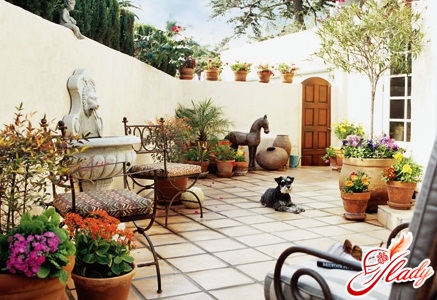
Decoration Materials
Wall decoration:The interior of a house in the Mediterranean style involves matte and textured wall surfaces, wallpaper or wood panels can only be found in high-class hotels. In Italian houses, you can find a variety of textures - from mosaic tiles to fresco wall paintings. Tiles are a must-have attribute of bathroom walls, and tiles are also used to decorate kitchen aprons. Hand-painted tiles are especially relevant. Imitation brickwork or bare bricks left in their natural state are also applicable to this style, but only in very limited quantities, for example, in the decoration of the fireplace area. Glue paints are best suited to imitate a wall with a rough texture, which also have the ability to play with light due to their opaque gloss. Finishing materials for floors: The Mediterranean style of home interiors definitely cannot do without tiles in the floor decoration, especially often used are terracotta and unglazed tiles. To create a feeling of warmth under your feet, you can use a heating system or Indian rugs. It is also possible to use laminate, but not soft vinyl coverings, as they look unnatural, especially in large areas. There are usually no more than two materials in the floor finishing of the entire house, due to which a feeling of visual unity and integrity of the space is created. To create a more festive interior, you can decorate the floor, for example in the hall, with marble mosaics, which can be either single-color or multi-colored with some kind of pattern. Using inexpensive white laminate on the floor in combination with white walls will also create a sense of elegance and, in addition, will reflect light as much as possible. Soft carpets made of wool or velor are absolutely inappropriate in the interior of a Mediterranean house, but you can use carpets in neutral tones and with a textured surface such as sisal or coconut fiber. Use of textiles: Textiles in a Mediterranean interior carry a functional load rather than a decorative one. The most popular are crisp white cotton, as well as primitive lace in cream shades. It is used as pillowcases and throws, runners and tablecloths, but there should not be too much of it, so as not to create a feeling of excessive luxury and chic.
Kitchen in Mediterranean style
The kitchen plays a very important role inMediterranean home, as it is the center of life for most families. That is why it should be functionally thought out and spacious enough. Kitchen furniture in this style consists of sideboards, open wall shelves and racks. To give the kitchen a touch of antiquity, complement its design with terracotta tiles. The interior of the kitchen in the Italian style is best formed with rattan and forged chairs and tables, as well as rack-type sideboards. Chairs with cane seats will fit most organically into the Greek interior. Important components of the kitchen in the Mediterranean style are: a stand-alone central island table for cooking, a butler sink, rough wooden or painted furniture and sideboards, kitchenware covered with ceramic glaze and utensils with naive hand painting.
Living room in the Mediterranean style
Many living rooms in Mediterranean homescombined with dining rooms, the "eating area" of which is organized according to the open-plan principle. Window decoration in this style is unthinkable without lattice wooden shutters, they are especially relevant in the doorway leading to the patio. Rough pine or aged oak furniture will fit perfectly into the living room interior, and forged elements should be introduced into it if you want to give the room an Italian accent. An open bookcase with hand-painted ceramics stored in it is an important attribute of the style. Airy muslin curtains are ideal for window decoration, but if you want to keep the room warm, then you can add thick curtains. Mesh on the windows will be absolutely inappropriate in this context, but it is quite possible to hang a translucent curtain to the middle of the window. The interior of the Mediterranean style living room includes: a low pine coffee table, a wood stove or its imitation, a sofa with an open wooden frame, a cotton rug and floors made of terracotta tiles or bleached floorboards.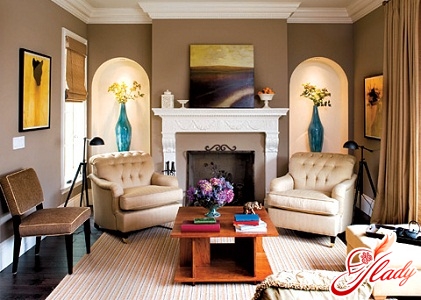
Bedroom in Mediterranean style
Mediterranean style home interiorinvolves using the most basic furnishings in the bedroom. This is certainly a low wrought iron or wooden bed, a solid wood wardrobe and an elegant small dressing table. To avoid the impression of excessive severity of the interior, it is worth adding embroidered and lace linen to its design, and hanging prints on the walls. You can also add elements such as a tapestry on the wall, and place a ceramic washbasin and a jug of water in the corner of the room. The interior of a bedroom in the Mediterranean style is impossible without shutters on the windows, simple cotton linen and only the most necessary furniture - a bed, wardrobe and chest of drawers.
Bathroom in Mediterranean style
The interior in the Mediterranean style involvesan exclusively functional bathroom only for washing and doing laundry, and not for relaxation and bliss. Such a bathroom is characterized by the use of surfaces that are easy to clean and wall-mounted plumbing fixtures. Such plumbing is very practical, because all the boxes are hidden in the walls, in addition, the space on the floor is freed up and easy to clean. Priority is given to a large shower stall rather than a bathtub. A bidet is not a luxury, but an essential component of the interior. Floors and walls are finished exclusively with ceramic tiles, ceramics should be only snow-white. A chromed towel holder with heating is used, and it is best to use textured waffle towels themselves, since they best match the European interior and absorb water very well. We recommend reading:




